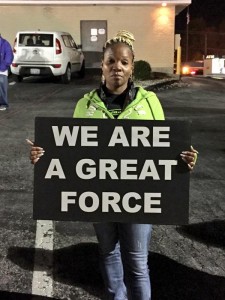Solidarity, Nonviolence, and Ferguson
A Catholic Worker Reflection – Jenny Truax
There are two Americas: one that privileges white people, and one for non-whites. The killing of Mike Brown and resistance in Ferguson have shown a bright light on this fact, making many of us white folks uncomfortable indeed. I am a seasoned, radical, anarchist Catholic Worker who believes in nonviolence and anti-racist principles; I thought that I “got it.” Despite having done and hospitality for homeless women and resistance work for over 15 years, my understanding of these two Americas resided more in my intellect than in my heart. Mike Brown and Ferguson have pushed me forward in the journey in ways I couldn’t have imagined. So I ask myself, what would I want to know? If it were you here in Ferguson, hearing these stories, marching on the street, and sitting in the forums, what would I want to you to tell me about what’s going on here? 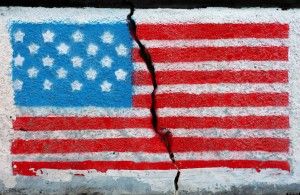
First, tell me about the context in which Mike Brown and Darren Wilson (the police officer who killed him) lived. It is true that both white people and African Americans call Ferguson home, but they don’t typically have access to the same neighborhoods, schools or businesses. Ferguson is functionally segregated, just like most other cities in this country, a result of white flight, sprawl, red-lining, and structural racism. Despite constituting less than a third of the population of Ferguson, white power is still firmly in control: 5 of 6 city council members are white, 6 of 7 school board members are white; 50 of 53 of the police officers are white.
Tell me what it has been like on the ground in Ferguson. It’s essential to understand that the extent of “protestor violence” and “looting” continue to be miniscule compared to the violence of the police during the past two months (despite the media focusing only on the former). Early on, the tanks moved in. Police dressed in camouflage, toted M-4 rifles and aimed them directly at us as we stood on the sidewalk. The police have consistently initiated the violence; they tear-gassed peacefully assembling crowds over several days, including events where children were present. (Ironically, the tear gas canisters are the same as those found in Palestine. We have received much love and support from Palestinians, including how to best recover from tear gas attacks: use milk!) The police fired rubber bullets into large groups of people. Recently, they have been targeting leaders leading chants by surging into the crowd, dragging them out, and arresting them. (This, during completely legal protests held on the sidewalk; First Amendment rights are not on their priority list.) The police have not hesitated to pepper spray, punch, beat, and hog-tie people during peaceable assemblies and arbitrarily raise bond amounts. Even with the presence of the Department of Justice here, the police consistently covered, or didn’t even wear their name badges. They continued to wear “I am Darren Wilson” wristbands for weeks after Mike Brown’s killing. The chant we often use, “Who do you serve? Who do you protect?” is hauntingly relevant here.
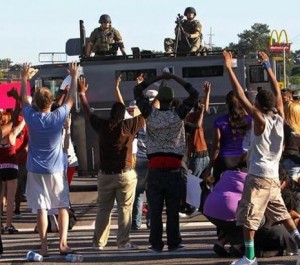 Remind me of the truth that sadly, Mike Brown’s murder is not an isolated or even unusual case. White society deems people of color as thugs, terrorists, criminals, and threats, instilling deep fear and irrationality that grow into structural racism. Unarmed Mike Brown, 18, heading off to college in days, was shot six times by Darren Wilson on August 9, 2014. In just the two months since Mike Brown’s killing, St. Louis police killed two more black people under questionable circumstances. It’s crucial for all of us to be aware of the fact that every 28 hours, a black person is killed by a police officer, security guard, or self-appointed vigilante in the U.S. The 2012 study that documented this noted that 44% of these people killed were unarmed, and in 27% of cases, the police claimed the suspect had a gun but there was no corroboration to prove this.1 How will we as a region and nation respond to the these devastating truths? Rev Osagyefo Sekou suggests that “the St. Louis region and the nation are presented with a clear choice: justice or shame.”
Remind me of the truth that sadly, Mike Brown’s murder is not an isolated or even unusual case. White society deems people of color as thugs, terrorists, criminals, and threats, instilling deep fear and irrationality that grow into structural racism. Unarmed Mike Brown, 18, heading off to college in days, was shot six times by Darren Wilson on August 9, 2014. In just the two months since Mike Brown’s killing, St. Louis police killed two more black people under questionable circumstances. It’s crucial for all of us to be aware of the fact that every 28 hours, a black person is killed by a police officer, security guard, or self-appointed vigilante in the U.S. The 2012 study that documented this noted that 44% of these people killed were unarmed, and in 27% of cases, the police claimed the suspect had a gun but there was no corroboration to prove this.1 How will we as a region and nation respond to the these devastating truths? Rev Osagyefo Sekou suggests that “the St. Louis region and the nation are presented with a clear choice: justice or shame.”
Remind me too that that Ferguson is not an island; it’s not unique or different than the city from which you’re reading this article. One of the biggest barricades enforcing the divide between the two Americas is the criminal “justice” system, which targets people of color at every level – disproportionate surveillance, arrests, prosecution, and sentences. For example, even though African-Americans use and sell drugs at about the same rate as whites, they are 2.8 to 5.5 times more likely to be arrested. While they constitute 13% of the nation’s population, they make up 40% of prison population.2 Our country’s racist legacy of the genocide of First Nations people, slavery, Jim Crow, and now, mass incarceration, continue to cause deep scars, many of which are ignored or denied by its white population. In his stunning article in The Atlantic, Ta-Nehisi Coates notes that “Indeed, in America there is a strange and powerful belief that if you stab a black person 10 times, the bleeding stops and the healing begins the moment the assailant drops the knife. We believe white dominance to be a fact of the inert past, a delinquent debt that can be made to disappear if only we don’t look. There has always been another way.”3 Ferguson is not an island. It is everywhere; it’s in the fabric of very city and town in this country. 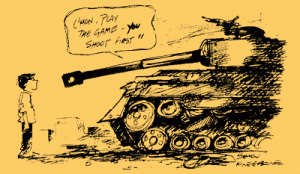
Talk to me about the more difficult lessons from Ferguson about solidarity and nonviolence. I’ve realized more fully that my rigid Catholic Worker devotion to nonviolence (which is somewhat grounded in my pattern as a white person to think “I know what is best,”) has blinded me to certain things. In past years, it has kept me from supporting many events led by people of color because they felt “uncomfortable”. This in turn has kept me disconnected from the black radical community in St. Louis. I’ve realized that in the past I’ve placed a “nonviolence litmus test” on events led by people of color that I didn’t on white-dominated events. For example, do I require the environmental or progressive Catholic groups I support to have a published commitment, and active track record of my style of radical nonviolence?
I’ve realized that as a person indoctrinated into white culture, I have at times not been thoughtful in the way I talk about nonviolence to people who have been absorbing state violence for decades, whether it be Palestinians or African Americans in Ferguson. Lately I’ve heard far too many white people complaining about the resistance, dismissing it as “undisciplined,” “intimidating,” or “a riot”. These observations, often fueled by unrecognized racism, can stem from lots of different places: a reliance on corporate media, white unconscious bias that associates “black” with “criminal,” and colonialism that encourages white folks to hoist our worldview onto a targeted population. Who gets to decide whether an action is nonviolent? Is it in the perception of the power-holders (white people?) That is, if I as a white person feel uncomfortable/called out/afraid, does that make the action violent? Is the level of nonviolence determined by the intentions of the participants? How loud can a black youth yell before white people (ensconced in centuries of white privilege) call her violent? These are important questions to reconsider within the new world that Ferguson has brought us.
When the tanks rolled into Ferguson, was I going to condemn the person next to me for throwing a water bottle? No, I chose to condemn the tank and the state violence fueling it, though I didn’t choose to throw anything myself. I won’t spend energy being distracted into thinking that small acts of property damage compare to the state violence that targets communities of color every day, in every town in this country. For what is the “acceptable” response to centuries of state violence, slavery, lynchings, rapes, mass incarceration, and the continued implementation of “separate but equal”? We ask the guests at Karen House, and receive a consistent answer: “Yep, they locked up my brother for walking while black.” “The police beat up my cousin on the street.” “I’ve got a felony, so I can’t find a job or an apartment.” People have a right to feel rage at yet another shooting of an unarmed black teenager and to yell about it to high heaven! For myself, I can help create events that jive with my personal belief in nonviolence, but I’m not going to tell people of color how they should be responding. It’s insulting and patronizing, adding more salt to the wound.
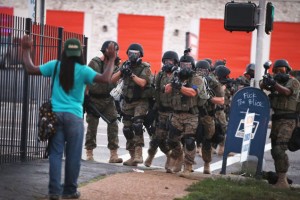 Ferguson exposes the fact that certain patterns of whiteness have watered-down the idea of nonviolence. Too often now, nonviolence looks polite, risk-less, non-threatening and compliant with state power (most often, the police.) Sometimes our civil disobedience centers ourselves, promoting a “White Hero Syndrome.” Are we focused only on white-dominated activism challenging state violence in other countries or are we making commitments to our neighbors, or to the people on whose stolen land we reside? Are we challenging the militant forces in our own communities – the police that have the very same weapons as the U.S. military forces in Afghanistan? What kind of priority are we giving to combatting racism, which undergirds so many of the social justice issues that progressives take on?
Ferguson exposes the fact that certain patterns of whiteness have watered-down the idea of nonviolence. Too often now, nonviolence looks polite, risk-less, non-threatening and compliant with state power (most often, the police.) Sometimes our civil disobedience centers ourselves, promoting a “White Hero Syndrome.” Are we focused only on white-dominated activism challenging state violence in other countries or are we making commitments to our neighbors, or to the people on whose stolen land we reside? Are we challenging the militant forces in our own communities – the police that have the very same weapons as the U.S. military forces in Afghanistan? What kind of priority are we giving to combatting racism, which undergirds so many of the social justice issues that progressives take on?
Nonviolence, if used in radical and community-building ways, is a powerful tool to pull ourselves out of the racist hole that white America – not exempting the Catholic Worker – has dug, and Ferguson gives us some guideposts. A commitment to nonviolence should mean examining our own activist groups and communities for structural racism – a vile, insidious and ubiquitous form of violence – and really digging into the question of why so many of these peace and justice groups are so white-dominated. For white people such as myself, practicing nonviolence can mean doing the personal work on the patterns of white culture that keep us from being connected to others. For white people committed to nonviolence, this committment should mean expanding relationships and coalitions with people and communities of color that are mutual, rather than based in white power (where we are the “helpers”). It should be about connecting war abroad with war at home.
Lastly, inspire me with the new insights on solidarity that are flowing from Ferguson. The most important lesson I’ve absorbed is that solidarity means following the lead of those most affected by injustice. It means that I as a white person need to step back, listen, and show up when people of color ask. It means I shouldn’t be controlling the actions, running the meetings, or telling people of color how to act. Of course I can decide how I participate, but when I control the messaging, ignore feedback, or think that I can tell African Americans how Martin Luther King Jr. would act in Ferguson in 2014, I am part of the problem. As bell hooks notes, “All our silences in the face of racist assault are acts of complicity.”4 Solidarity can mean doing things that are uncomfortable: showing up to events when we don’t know a lot of people, lovingly correcting racism in other white people, and seeking ways to be supportive, even if we won’t get any credit.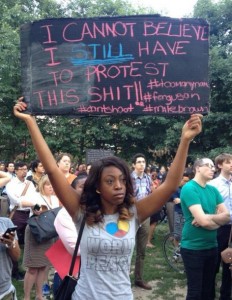
Thinking about what solidarity means today, I’ve been re-inspired by Dr. Martin Luther King Jr.’s “Letter from the Birmingham Jail,” paraphrased here: “I must confess that over the past few years I have been gravely disappointed with the white moderate. I have almost reached the regrettable conclusion that the Negro’s great stumbling block in the stride toward freedom is not the White Citizen’s Counciler or the Ku Klux Klanner, but the white moderate… This person is more devoted to “order” than to justice; prefers a negative peace (which is the absence of tension) to a positive peace (which is the presence of justice). This person constantly says: ‘I agree with you in the goal you seek, but I cannot agree with your methods of direct action’; paternalistically believes [in setting] the timetable for another person’s freedom; and lives by a mythical concept of time, constantly advising the Negro to wait for a ‘more convenient season.’ Shallow understanding from people of goodwill is more frustrating than absolute misunderstanding from people of ill will. Lukewarm acceptance is much more bewildering than outright rejection.”
Mario E. Jones observed that “the only thing that’s changed since we were brought over here in the 1500’s is the type of chains being used.” Whether or not Darren Wilson is indicted, the struggle for Justice for Mike Brown will continue. The movement will continue to challenge racial profiling, Stop and Frisk policies, the lack of police accountability, mass incarceration, and the myriad of laws and policies that target non-whites in this country. We don’t have to live separated from one another in two Americas. Together, let’s shed our fear, continue to ask the hard questions of ourselves and each other, and call for justice. For Mike Brown. For Ferguson. For us all.
- https://mxgm.org/report-on-the-extrajudicial-killings-of-120-black-people/
- Ibid
- “The Case for Reparations, ” The Atlantic, Ta-Nehisi Coates
- Killing Rage: Ending Racism – bell hooks
